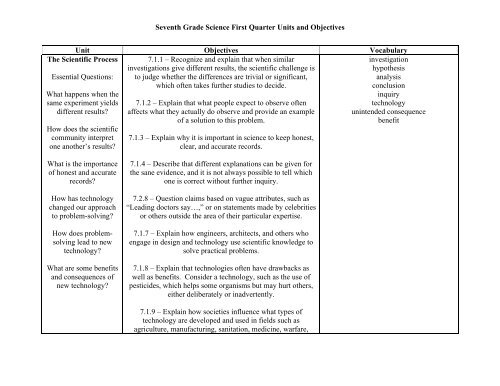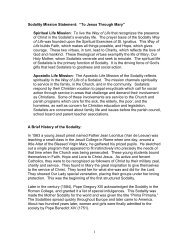+ 7th Grade Science - 1st Quarter Goals (PDF) - St. Hugh Of ...
+ 7th Grade Science - 1st Quarter Goals (PDF) - St. Hugh Of ...
+ 7th Grade Science - 1st Quarter Goals (PDF) - St. Hugh Of ...
Create successful ePaper yourself
Turn your PDF publications into a flip-book with our unique Google optimized e-Paper software.
Seventh <strong>Grade</strong> <strong>Science</strong> First <strong>Quarter</strong> Units and Objectives<br />
Unit Objectives Vocabulary<br />
The Scientific Process 7.1.1 – Recognize and explain that when similar<br />
investigations give different results, the scientific challenge is<br />
Essential Questions: to judge whether the differences are trivial or significant,<br />
which often takes further studies to decide.<br />
What happens when the<br />
same experiment yields<br />
different results?<br />
How does the scientific<br />
community interpret<br />
one another’s results?<br />
7.1.2 – Explain that what people expect to observe often<br />
affects what they actually do observe and provide an example<br />
of a solution to this problem.<br />
7.1.3 – Explain why it is important in science to keep honest,<br />
clear, and accurate records.<br />
investigation<br />
hypothesis<br />
analysis<br />
conclusion<br />
inquiry<br />
technology<br />
unintended consequence<br />
benefit<br />
What is the importance<br />
of honest and accurate<br />
records?<br />
How has technology<br />
changed our approach<br />
to problem-solving?<br />
How does problemsolving<br />
lead to new<br />
technology?<br />
What are some benefits<br />
and consequences of<br />
new technology?<br />
7.1.4 – Describe that different explanations can be given for<br />
the sane evidence, and it is not always possible to tell which<br />
one is correct without further inquiry.<br />
7.2.8 – Question claims based on vague attributes, such as<br />
“Leading doctors say…,” or on statements made by celebrities<br />
or others outside the area of their particular expertise.<br />
7.1.7 – Explain how engineers, architects, and others who<br />
engage in design and technology use scientific knowledge to<br />
solve practical problems.<br />
7.1.8 – Explain that technologies often have drawbacks as<br />
well as benefits. Consider a technology, such as the use of<br />
pesticides, which helps some organisms but may hurt others,<br />
either deliberately or inadvertently.<br />
7.1.9 – Explain how societies influence what types of<br />
technology are developed and used in fields such as<br />
agriculture, manufacturing, sanitation, medicine, warfare,
Seventh <strong>Grade</strong> <strong>Science</strong> First <strong>Quarter</strong> Units and Objectives<br />
Systems in Space<br />
Essential Questions:<br />
Why is the sun the most<br />
important star in our<br />
galaxy to us?<br />
How do we receive the<br />
sun’s energy?<br />
What is happening to<br />
the sun as is emits<br />
light?<br />
Systems on Earth<br />
Essential Questions:<br />
How does the rock<br />
cycle affect Earth’s<br />
climate?<br />
How does the rock<br />
cycle influence Earth’s<br />
landforms and oceans?<br />
transportation, information processing, and communication.<br />
7.1.10 – Identify ways that technology has strongly influenced<br />
the course of history and continues to do so.<br />
7.3.1 – Recognize and describe that the sun is a medium-sized<br />
star located near the edge of a disk-shaped galaxy of stars and<br />
that the universe contains many billions of galaxies and each<br />
galaxy contains many billions of stars.<br />
7.3.2 – Recognize and describe that the sun is many thousands<br />
of times closer to Earth than any other star, allowing light<br />
from the sun to reach Earth in a few minutes. Note that this<br />
may be compared to time spans of longer than a year for all<br />
other stars.<br />
7.3.11 – Explain that the sun loses energy by emitting light.<br />
Note than only a tiny fraction of that light reaches Earth.<br />
Understand that the sun’s energy arrives as light with a wide<br />
range of wavelengths, consisting of visible light and infrared<br />
and ultraviolet radiation.<br />
7.3.5 – Recognize and explain that heat energy carried by<br />
ocean currents has a strong influence on climate around the<br />
world.<br />
7.3.3 – Describe how climates sometimes have changed<br />
abruptly in the past as a result of changes in Earth’s crust,<br />
such as volcanic eruptions or impacts of huge rocks from<br />
space.<br />
7.3.6 – Describe how gas and dust from large volcanoes can<br />
change the atmosphere.<br />
star<br />
galaxy<br />
universe<br />
energy<br />
light<br />
speed of light<br />
wavelength<br />
visible light<br />
radiation<br />
infrared radiation<br />
ultraviolet radiation<br />
climate<br />
current<br />
volcano<br />
earthquake<br />
impact<br />
atmosphere<br />
eruption<br />
erosion<br />
weathering<br />
magma<br />
lava<br />
crust
Seventh <strong>Grade</strong> <strong>Science</strong> First <strong>Quarter</strong> Units and Objectives<br />
How do rocks and<br />
landforms help us learn<br />
about Earth’s history?<br />
7.3.7 – Give examples of some changes in Earth’s surface that<br />
are abrupt, such as earthquakes and volcanic eruptions, and<br />
some changes that happen very slowly, such as uplift and<br />
wearing down of mountains and the actions of glaciers.<br />
7.3.4 – Explain how heat flow and movement of material<br />
within Earth causes earthquakes and volcanic eruptions and<br />
creates mountains and ocean basins.<br />
7.3.8 – Describe how sediments of sand and smaller particles,<br />
sometimes containing the remains of organisms, are gradually<br />
buried and are cemented together by dissolved minerals to<br />
form solid rock again.<br />
7.3.9 – Explain that sedimentary rock, when buried deep<br />
enough, may be reformed by pressure and heat, perhaps<br />
melting and recrystallizing into different kinds of rock.<br />
Describe that these reformed rock layers may be forced up<br />
again to become land surface and even mountains, and<br />
subsequently erode.<br />
7.3.10 – Explain how the thousands of layers of sedimentary<br />
rock can confirm the long history of the changing surface of<br />
Earth and the changing life forms whose remains are found in<br />
successive layers, although the youngest layers are not always<br />
found on top, because of folding, breaking, and uplifting of<br />
layers.<br />
mantle<br />
core<br />
sediment<br />
sedimentary rock<br />
igneous rock<br />
metamorphic rock<br />
rock cycle












